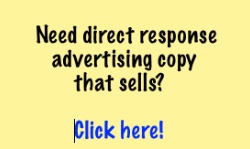Way back in 2007, I gave a talk on how to write winning sales copy at one of Jay Abraham’s marketing seminars in Los Angeles.
The audience seemed to enjoy it and, thankfully, they laughed at my jokes. No groans… no crickets. All in all, it was great fun.
At the end of my talk, I made a simple offer: “Give me your email address and I’ll send you a free list of ‘Advertising Power Words.'”
Not much of a lead magnet (especially by today’s standards), but better than nothing. And it yielded me a 56-name haul — names that eventually became the foundation of the list to which I send this ezine.
Two other lead magnets followed. The first was based on an interview with me that copywriting giant Clayton Makepeace published in his defunct and sorely missed ezine, “The Total Package.”
The second was a checklist I created to go along with an interview I did for business consultant Wes Murph’s “Marketing Maniac” podcast.
These lead magnets exist to ethically bribe anyone who visits my website into giving me their email address, so I can send them this ezine.
And then, with some help from my lead magnet, this ezine (hopefully) helps me…
1) build a relationship with you…
2) establish authority and credibility when it comes to copywriting and marketing by providing you with something of value on a regular basis…
3) sell you on hiring me for a copywriting or consulting project…
4) sell you on buying products and services from others that I have found valuable and useful.
However, none of that can happen if my lead magnet fails to entice you into joining my list. And creating a lead magnet that does that is harder than it sounds.
In the old days (15 or 20 years ago), collecting email addresses was infinitely easier than it is today. People were often eager to get free reports, videos, checklists, courses, consults and what-not. And giving up their email address seemed a small price to pay.
But, as you know, these days, we are absolutely inundated with offers like that. More in a month than you could possibly consume in five years. A brief glance at the ebooks folder on my computer yields hundreds and hundreds of freebies (and a shocking number of paid products, as well) that I have never even glanced at.
Not because they aren’t any good… not because they don’t contain valuable information… not because I don’t want to learn from them… but simply because I don’t have time to go through all that stuff (and more comes in every day).
The point is, if you’re going to entice someone to cough up their email address, it’s important that you craft a lead magnet that…
1) Covers something of immediate interest to your ideal prospect…
2) Offers a powerful solution to the primary problem your prospect is facing right now (you can’t solve every problem in one report and you want your prospect to come back for more)…
3) Has real value, not just fluff — though it’s okay to tell them what to do while saving how to do it for a paid course or service…
4) Is quick and easy to consume (no 500 page opuses or 15-part video courses please).
It can be a short problem-solving report…
…a checklist that makes a task easier or that ensures the prospect has crossed all the t’s and dotted all the i’s…
…a case study that shows how you solved the problem for someone else…
…templates that make doing one task or another brain dead simple…
…a list of tools or resources…
…or something else that has immediate appeal to your prospects.
But keep in mind, you’re not married to whatever you come up the first time around… nor are you limited to just one lead magnet. You can test different lead magnets… you can offer a collection of lead magnets… you can offer different lead magnets to different segments of your target market.

